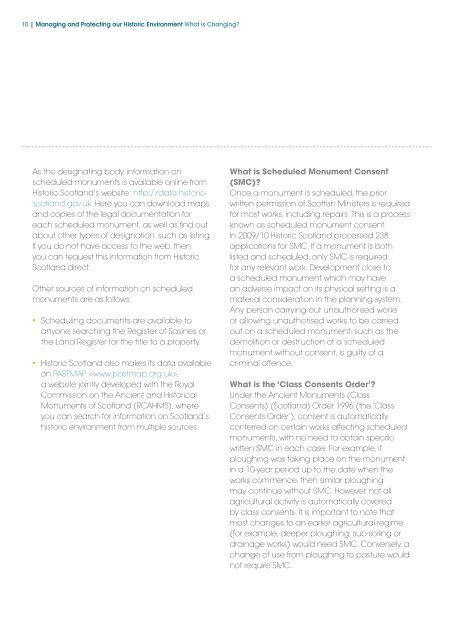Managing and Protecting our Historic ... - Historic Scotland
Managing and Protecting our Historic ... - Historic Scotland
Managing and Protecting our Historic ... - Historic Scotland
Create successful ePaper yourself
Turn your PDF publications into a flip-book with our unique Google optimized e-Paper software.
10 | <strong>Managing</strong> <strong>and</strong> <strong>Protecting</strong> <strong>our</strong> <strong>Historic</strong> Environment What is Changing?<br />
As the designating body, information on<br />
scheduled monuments is available online from<br />
<strong>Historic</strong> Scotl<strong>and</strong>’s website: http://data.historicscotl<strong>and</strong>.gov.uk.<br />
Here you can download maps<br />
<strong>and</strong> copies of the legal documentation for<br />
each scheduled monument, as well as find out<br />
about other types of designation, such as listing.<br />
If you do not have access to the web, then<br />
you can request this information from <strong>Historic</strong><br />
Scotl<strong>and</strong> direct.<br />
Other s<strong>our</strong>ces of information on scheduled<br />
monuments are as follows:<br />
• Scheduling documents are available to<br />
anyone searching the Register of Sasines or<br />
the L<strong>and</strong> Register for the title to a property.<br />
• <strong>Historic</strong> Scotl<strong>and</strong> also makes its data available<br />
on PASTMAP ,<br />
a website jointly developed with the Royal<br />
Commission on the Ancient <strong>and</strong> <strong>Historic</strong>al<br />
Monuments of Scotl<strong>and</strong> (RCAHMS), where<br />
you can search for information on Scotl<strong>and</strong>’s<br />
historic environment from multiple s<strong>our</strong>ces.<br />
What is Scheduled Monument Consent<br />
(SMC)?<br />
Once a monument is scheduled, the prior<br />
written permission of Scottish Ministers is required<br />
for most works, including repairs. This is a process<br />
known as scheduled monument consent.<br />
In 2009/10 <strong>Historic</strong> Scotl<strong>and</strong> processed 238<br />
applications for SMC. If a monument is both<br />
listed <strong>and</strong> scheduled, only SMC is required<br />
for any relevant work. Development close to<br />
a scheduled monument which may have<br />
an adverse impact on its physical setting is a<br />
material consideration in the planning system.<br />
Any person carrying out unauthorised works<br />
or allowing unauthorised works to be carried<br />
out on a scheduled monument, such as the<br />
demolition or destruction of a scheduled<br />
monument without consent, is guilty of a<br />
criminal offence.<br />
What is the ‘Class Consents Order’?<br />
Under the Ancient Monuments (Class<br />
Consents) (Scotl<strong>and</strong>) Order 1996 (the ‘Class<br />
Consents Order’), consent is automatically<br />
conferred on certain works affecting scheduled<br />
monuments, with no need to obtain specific<br />
written SMC in each case. For example, if<br />
ploughing was taking place on the monument<br />
in a 10-year period up to the date when the<br />
works commence, then similar ploughing<br />
may continue without SMC. However, not all<br />
agricultural activity is automatically covered<br />
by class consents. It is important to note that<br />
most changes to an earlier agricultural regime<br />
(for example, deeper ploughing, sub-soiling or<br />
drainage works) would need SMC. Conversely, a<br />
change of use from ploughing to pasture would<br />
not require SMC.













![Elgin Cathedral Wedding Brochure [pdf, 544kb] - Historic Scotland](https://img.yumpu.com/22301571/1/190x151/elgin-cathedral-wedding-brochure-pdf-544kb-historic-scotland.jpg?quality=85)



